Parents,
This week, I missed my students on Monday and Tuesday; however, it was for a very exciting opportunity! Earlier this year, I wrote a proposal on inquiry-based learning and was chosen to present at the Georgia Association for Gifted Children's annual conference in Athens. I was proud to speak in front of peers who are also passionate about teaching our gifted youth. I also learned many new ideas from the other presenters that I am excited to bring into my classroom!
Ashley Rolader
COGBURN W00DS TAG
Cogburn TAG
Friday, March 18, 2016
3rd Graders Use STEM to Learn about Ancient Civilizations!
This week, we made a BRIDGE (pun intended!) from Ancient Rome to Ancient Egypt. We learned about how these civilizations transported water from water sources to cities and crops in order to survive. After the STEM activity, we studied Ancient Egyptian canals and the Nile River floods as well as Ancient Roman aqueducts.
STEM engineering activity.
Students were given the task of transporting water from a source to a bucket located at the other end of a table. They were given paper plates, cups, straws, and tape to make their structures. The goal was to move as much water into the bucket with as little spillage (leaks!) as possible. What fun!
The kids had some great discussions as they explored scientific principles like gravity. I offered very little information, and they weren't given any additional materials -- despite the begging and pleading that predictably occurred! It was fascinating to watch as they developed more creative solutions to their problems when I told them they had to "figure out" alternatives!
For example, several groups figured out that they could "test" water flow by instead blowing through one end of the tubing. They tested for leaks by feeling if air escaped and determined the likelihood of water making it to the bucket. My favorite quote of the week was from Audrey: "If it's airtight, it should be watertight!" That's a pretty awesome scientific deduction!
STEM engineering activity.
Students were given the task of transporting water from a source to a bucket located at the other end of a table. They were given paper plates, cups, straws, and tape to make their structures. The goal was to move as much water into the bucket with as little spillage (leaks!) as possible. What fun!
The kids had some great discussions as they explored scientific principles like gravity. I offered very little information, and they weren't given any additional materials -- despite the begging and pleading that predictably occurred! It was fascinating to watch as they developed more creative solutions to their problems when I told them they had to "figure out" alternatives!
For example, several groups figured out that they could "test" water flow by instead blowing through one end of the tubing. They tested for leaks by feeling if air escaped and determined the likelihood of water making it to the bucket. My favorite quote of the week was from Audrey: "If it's airtight, it should be watertight!" That's a pretty awesome scientific deduction!
The construction begins...
Now it's on to testing!
There were a few leaks and a few groups whose structures did not work as the teams had hoped. As a teacher, I believe this was the most valuable part of the experiment. We focused on discovering how we can learn from our mistakes and discussed which scientific principles affected the outcome. I promise -- every student in the class thought of ways they would have changed their design for improvement!
Last, we measured the amount of water that made it into the bucket across the table.
Results:
1. Hunter and Gabe
2. Shreyas
3. Reema, Risha, Maria, and Nicole
4. Ellie and Evan
5. Krithin, Nicket, Rayyan, and Romel
Congrats, teams!
Wednesday, March 16, 2016
5th Grade students use SCAMPER to design an improved cast for the future!
SCAMPER is a technique you can use to spark your creativity and help you overcome any challenge you may be facing. SCAMPER is based on the notion that everything new is a modification of something that already exists. Each letter in the acronym represents a different way you can play with the characteristics of what is challenging you to trigger new ideas.
S=Substitute
C= Combine
A=Adapt
M=Magnify
P=Put to other Uses
E=Eliminate (or minify)
R=Rearrange (or Reverse)
Using this information, students then designed an improved cast for the future.
S=Substitute
C= Combine
A=Adapt
M=Magnify
P=Put to other Uses
E=Eliminate (or minify)
R=Rearrange (or Reverse)
Using this information, students then designed an improved cast for the future.
Wednesday, March 9, 2016
Diving Through Sunlit Waters!
Second graders took a tour of two biomes located in the sunlight zone of our oceans: coral reefs and kelp forests.
First, they looked at pictures of the coral reef to find commonalities and infer information about the biodiversity found there. Beautiful pictures!
Next, we discussed the needs of giant kelp. We determined that these long plants need some way to help them reach the sunlight in order to photosynthesize. We used creative thinking to think of ways the plant may have adapted to solve this problem. Using balloons (air bladders), streamers (stipes and blades), and weighted bags (holdfasts), we made models of giant kelp and talked about the anatomy.
We explored the concepts of camouflage by hunting for different colored cards, and explored what it may be like to be an animal living in a kelp forest. To end the day, students compared and contrasted the coral reef and the kelp forest to find similarities and differences between the two biomes.
First, they looked at pictures of the coral reef to find commonalities and infer information about the biodiversity found there. Beautiful pictures!
Then....WE CREATED OUR VERY OWN KELP FOREST!
We explored the concepts of camouflage by hunting for different colored cards, and explored what it may be like to be an animal living in a kelp forest. To end the day, students compared and contrasted the coral reef and the kelp forest to find similarities and differences between the two biomes.
Historical and Mythological Figures Become Boots on the Field!
If you created a fictional army from historical people and mythological characters, who would you want on your side? Who would you be willing to battle?
Third grade students were given this same task, along with biographies and myths to read. They analyzed each person based on character traits, strengths, and weaknesses and were given the following job positions to fill:
The catch? Any person/character not chosen for their army would surely be hired by the opposing army! Eek!
- General
- Intelligence Officer
- Undercover Agent
- Diplomat
- Soldier
The catch? Any person/character not chosen for their army would surely be hired by the opposing army! Eek!
Who were their choices?
- Julius Caesar
- Alexander the Great
- Pythagoras
- Socrates
- Hercules
- Medusa
- Athena
- Mercury
Third graders also created mosaics based on their research of Greek and Roman art. After analyzing the art to determine subject matter themes, they created their own pieces to reflect either daily life or the mythology of Ancient Rome or Ancient Greece.
Subscribe to:
Posts (Atom)






















































